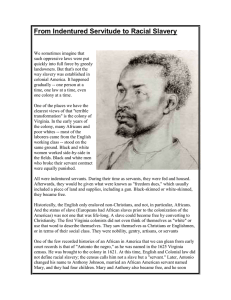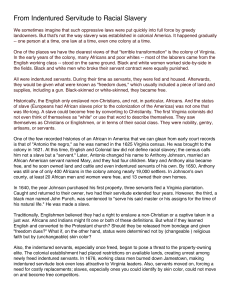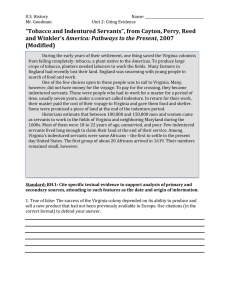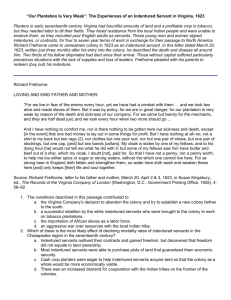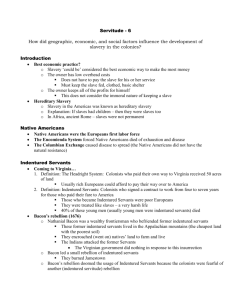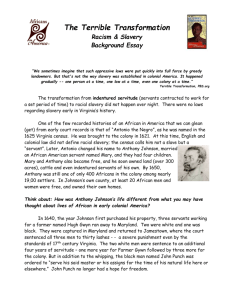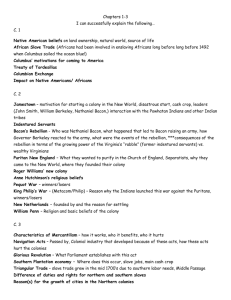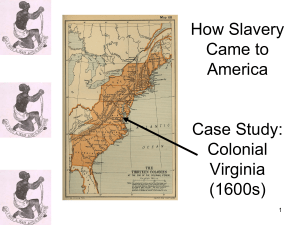From Indentured Servitude to Racial Slavery
advertisement
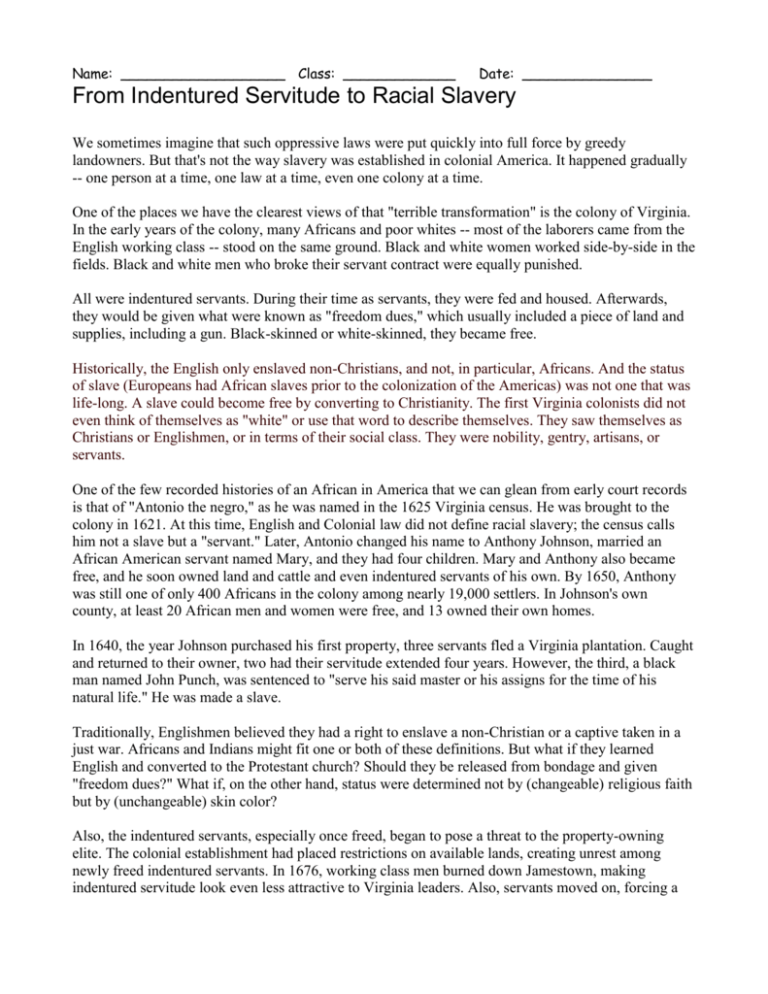
Name: ___________________ Class: _____________ Date: _______________ From Indentured Servitude to Racial Slavery We sometimes imagine that such oppressive laws were put quickly into full force by greedy landowners. But that's not the way slavery was established in colonial America. It happened gradually -- one person at a time, one law at a time, even one colony at a time. One of the places we have the clearest views of that "terrible transformation" is the colony of Virginia. In the early years of the colony, many Africans and poor whites -- most of the laborers came from the English working class -- stood on the same ground. Black and white women worked side-by-side in the fields. Black and white men who broke their servant contract were equally punished. All were indentured servants. During their time as servants, they were fed and housed. Afterwards, they would be given what were known as "freedom dues," which usually included a piece of land and supplies, including a gun. Black-skinned or white-skinned, they became free. Historically, the English only enslaved non-Christians, and not, in particular, Africans. And the status of slave (Europeans had African slaves prior to the colonization of the Americas) was not one that was life-long. A slave could become free by converting to Christianity. The first Virginia colonists did not even think of themselves as "white" or use that word to describe themselves. They saw themselves as Christians or Englishmen, or in terms of their social class. They were nobility, gentry, artisans, or servants. One of the few recorded histories of an African in America that we can glean from early court records is that of "Antonio the negro," as he was named in the 1625 Virginia census. He was brought to the colony in 1621. At this time, English and Colonial law did not define racial slavery; the census calls him not a slave but a "servant." Later, Antonio changed his name to Anthony Johnson, married an African American servant named Mary, and they had four children. Mary and Anthony also became free, and he soon owned land and cattle and even indentured servants of his own. By 1650, Anthony was still one of only 400 Africans in the colony among nearly 19,000 settlers. In Johnson's own county, at least 20 African men and women were free, and 13 owned their own homes. In 1640, the year Johnson purchased his first property, three servants fled a Virginia plantation. Caught and returned to their owner, two had their servitude extended four years. However, the third, a black man named John Punch, was sentenced to "serve his said master or his assigns for the time of his natural life." He was made a slave. Traditionally, Englishmen believed they had a right to enslave a non-Christian or a captive taken in a just war. Africans and Indians might fit one or both of these definitions. But what if they learned English and converted to the Protestant church? Should they be released from bondage and given "freedom dues?" What if, on the other hand, status were determined not by (changeable) religious faith but by (unchangeable) skin color? Also, the indentured servants, especially once freed, began to pose a threat to the property-owning elite. The colonial establishment had placed restrictions on available lands, creating unrest among newly freed indentured servants. In 1676, working class men burned down Jamestown, making indentured servitude look even less attractive to Virginia leaders. Also, servants moved on, forcing a need for costly replacements; slaves, especially ones you could identify by skin color, could not move on and become free competitors. In 1641, Massachusetts became the first colony to legally recognize slavery. Other states, such as Virginia, followed. In 1662, Virginia decided all children born in the colony to a slave mother would be enslaved. Slavery was not only a life-long condition; now it could be passed, like skin color, from generation to generation. Questions: Use complete sentences to answer each of the following questions. 1. What punishments were given to indentured servants who ran away before their contract was up? Did everyone get the same punishment? Explain. 2. According to the reading, explain three advantages of having African slaves, instead of indentured servants of any race. (answer should be at least one paragraph long) 3. The first paragraph of the reading says that “[Slavery] happened gradually -- one person at a time, one law at a time, even one colony at a time.” Explain what this means, using examples from the reading. (answer should be at least one paragraph long)
